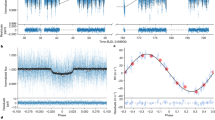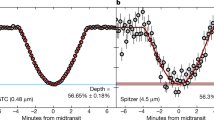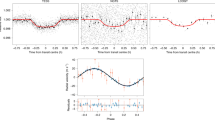Abstract
Some three dozen objects have now been discovered1,2,3,4,5 beyond the orbit of Neptune and classified as members of the Kuiper belt—a remnant population of icy planetesimals that failed to be incorporated into planets. At still greater distances is believed to lie the Oort cloud—a massive population of cometary objects distributed approximately in a sphere of characteristic dimension 50,000au(ref. 6). Here we report the discovery of an object, 1996TL66, that appears to be representative of a population of scattered bodies located between the Kuiper belt and the Oort cloud. 1996TL66has an orbital semimajor axis of 84au, and is in an extremely eccentric and highly inclined orbit (e = 0.58, i = 24°). With a red magnitude ∼20.9, it is the brightest trans-neptunian object yet found since Pluto and Charon. Its discovery suggests that the Kuiper belt extends substantially beyond the 30–50auregion sampled by previous surveys, and may contain much more mass than previously suspected.
This is a preview of subscription content, access via your institution
Access options
Subscribe to this journal
Receive 51 print issues and online access
$199.00 per year
only $3.90 per issue
Buy this article
- Purchase on Springer Link
- Instant access to full article PDF
Prices may be subject to local taxes which are calculated during checkout


Similar content being viewed by others
References
Jewitt, D. C. & Luu, J. X. Discovery of the candidate Kuiper belt object 1992 QB1. Nature 362, 730–732 (1993).
Jewitt, D. C. & Luu, J. X. The solar system beyond Neptune. Astron. J. 109, 1867–1876 (1995).
Williams, I. P., O'Ceallaigh, D. P., Fitzsimmons, A. & Marsden, B. G. The slow moving objects 1993 SB and 1993 SC. Icarus 116, 180–185 (1995).
Irwin, M., Tremaine, S. & Zytkow, A. N. Asearch for slow-moving objects and the luminosity function of the Kuiper belt. Astron. J. 110, 3082–3092 (1995).
Jewitt, D. C., Luu, J. X. & Chen, J. The Mauna Kea-Cerro-Tololo (MKCT) Kuiper belt and Centaur survey. Astron. J. 112, 1225–1238 (1996).
Oort, J. H. The structure of the cloud of comets surrounding the solar system and a hypothesis concerning its origin. Bull. Astron. Inst. Neth. 11, 91–110 (1950).
Trujillo, C. & Jewitt, D. Asemi-automated sky survey for Kuiper belt objects suitable for a Pluto Express Mission encounter. Astron. J.(submitted).
Marsden, B. G. in Completing the Inventory of the Solar System (eds Rettig, T. W. & Hahn, J. M.) 193–207 (ASP Conf. Ser. Vol. 107,Astron. Soc. Pacif., San Francisco, (1996).
Luu, J. X. & Jewitt, D. C. in Completing the Inventory of the Solar System (eds Rettig, T. W. & Hahn, J. M.) 245–254 (ASP Conf. Ser. Vol. 107,Astron. Soc. Pacif., San Francisco, (1996)).
Minor Planet Electronic Circ. 1997-B18 (1997).
Minor Planet Electronic Circ. 1997-C12 (1997).
Hogg, D. W., Quinlan, G. D. & Tremaine, S. Dynamical limits on dark mass in the outer solar system. Astron. J. 101, 2274–2286 (1991).
Whipple, F. L. Acomet model I: the acceleration of comet Encke. Astrophys. J. 111, 375–394 (1950).
Kuiper, G. P. in Astrophysics (ed. Hynek, J. A.) 357–424 (McGraw-Hill, New York, (1951)).
Ip, W.-H. Dynamical processes of macro-accretion of Uranus and Neptune—a first look. Icarus 80, 167–178 (1989).
Ip, W.-H. & Fernández, J. A. Steady-state injection of short-period comets from the trans-Neptunian cometary belt. Icarus 92, 185–193 (1991).
Torbett, M. Chaotic motion in a comet disk beyond Neptune—the delivery of short-period comets. Astron. J. 98, 1477–1482 (1989).
Morbidelli, A. & Valsecchi, G. Neptune scattered planetesimals could have sculpted the primordial Kuiper belt. Icarus(submitted).
Duncan, M. & Levison, H. Science (submitted).
Morbidelli, A., Thomas, F. & Moons, M. The resonant structure of the Kuiper belt and the dynamics of the first five trans-Neptunian objects. Icarus 118, 322–340 (1996).
Acknowledgements
We thank M. Holman for discussions, G. Williams for providing Fig. 2 , and W.Brown for help with the observations.
Author information
Authors and Affiliations
Corresponding author
Rights and permissions
About this article
Cite this article
Luu, J., Marsden, B., Jewitt, D. et al. A new dynamical class of object in the outer Solar System. Nature 387, 573–575 (1997). https://doi.org/10.1038/42413
Received:
Accepted:
Issue Date:
DOI: https://doi.org/10.1038/42413
This article is cited by
-
Long-term orbital dynamics of trans-Neptunian objects
Celestial Mechanics and Dynamical Astronomy (2020)
-
Origin and Evolution of the Cometary Reservoirs
Space Science Reviews (2015)
-
A Model for the Common Origin of Jupiter Family and Halley Type Comets
Earth, Moon, and Planets (2013)
-
Origin of Comet Nuclei and Dynamics
Space Science Reviews (2008)
-
The Dynamics of Objects in the Inner Edgeworth–Kuiper Belt
Earth, Moon, and Planets (2005)
Comments
By submitting a comment you agree to abide by our Terms and Community Guidelines. If you find something abusive or that does not comply with our terms or guidelines please flag it as inappropriate.



